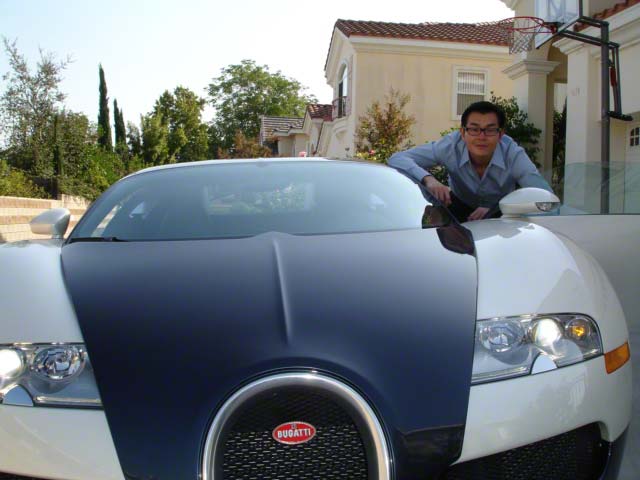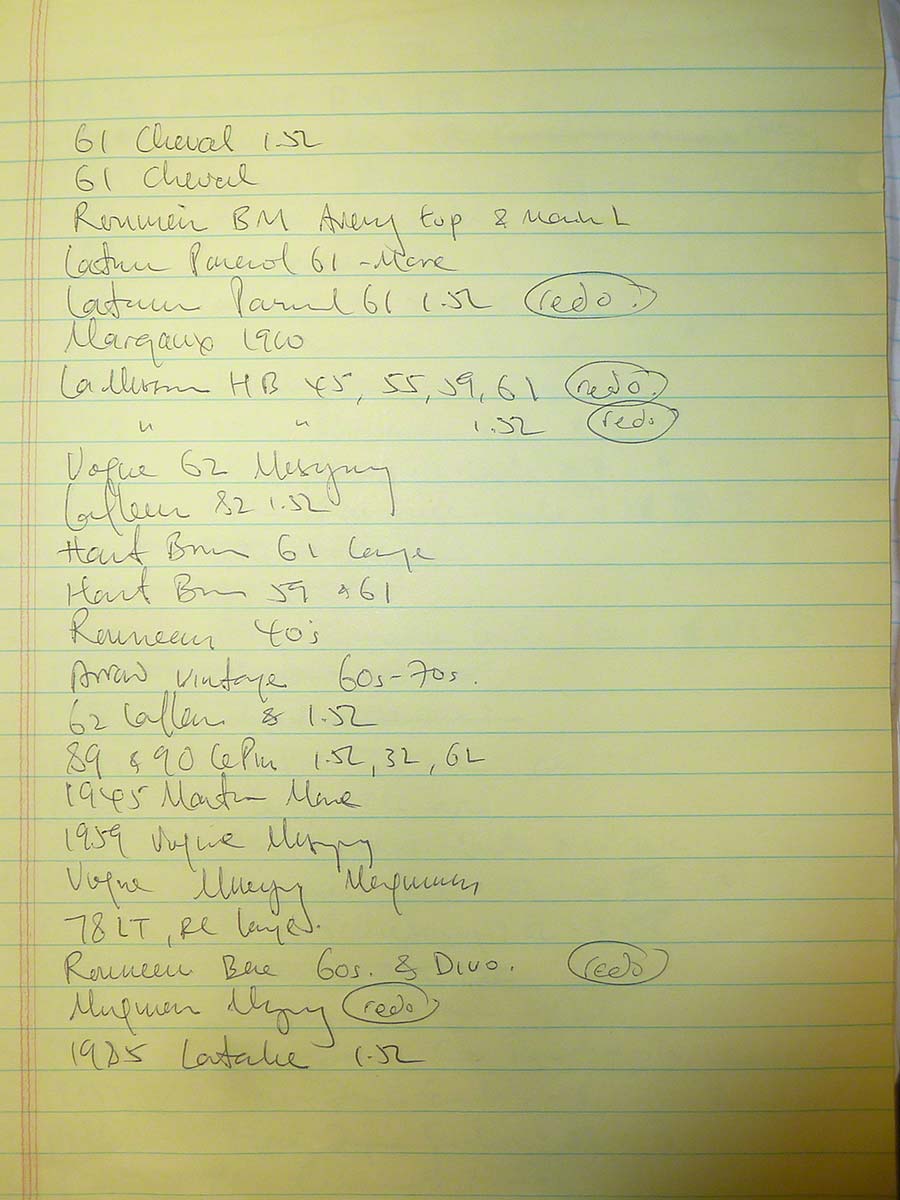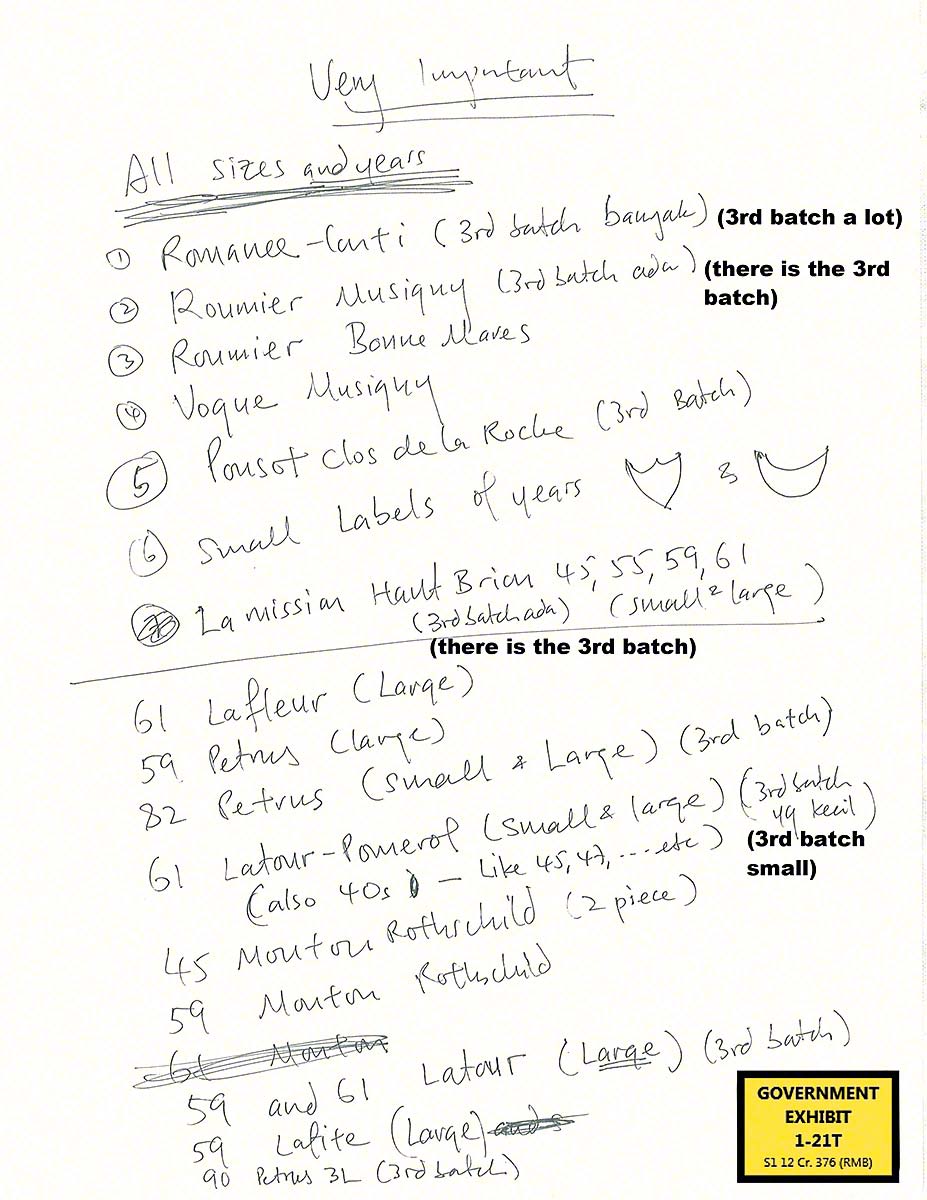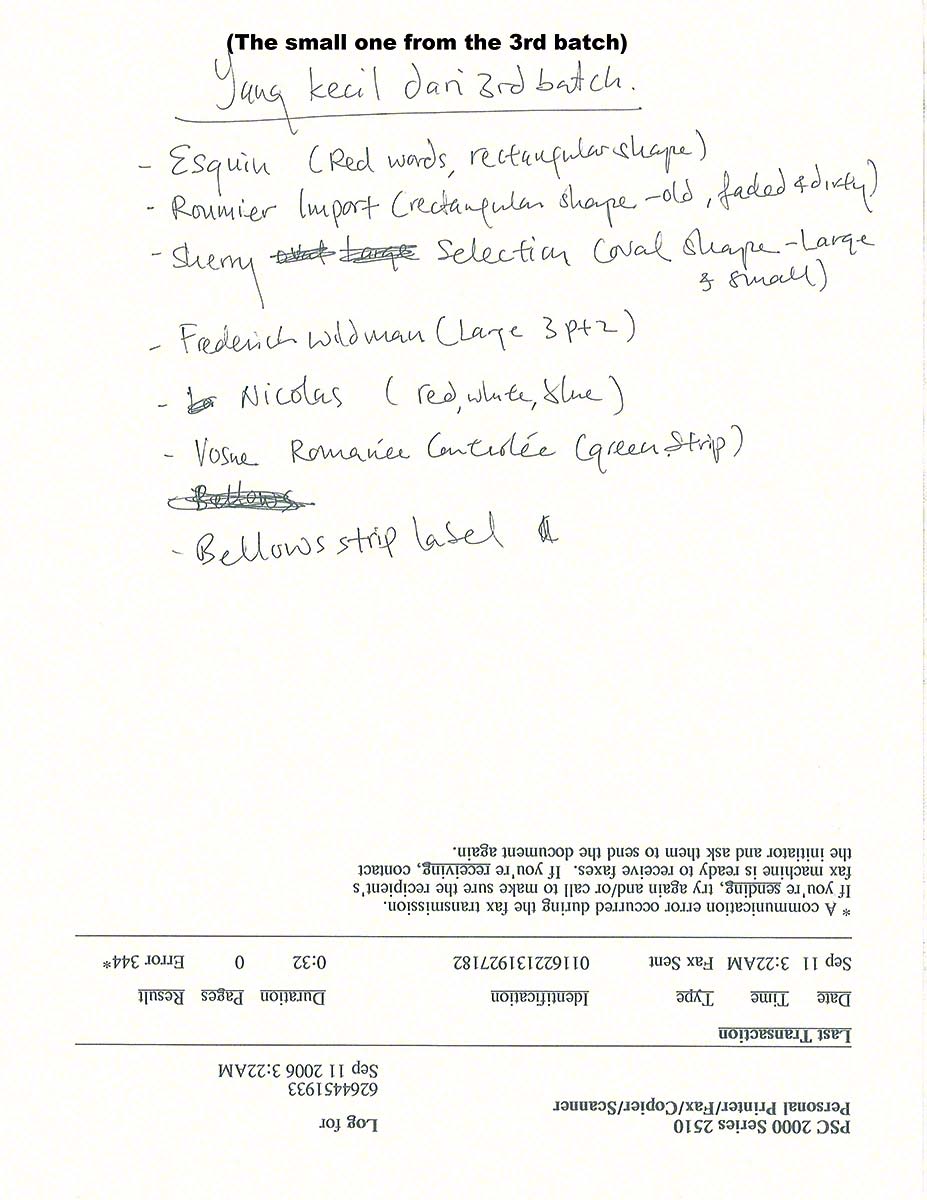The Trial: Part 14
A Multi-Part Feature on the trial of Rudy Kurniawan, including the transcripts, testimony and evidence that put the largest wine counterfeiter of our time behind bars.
DAY 7, TUESDAY 17TH DECEMBER 2013
Judge Berman and counsel for both the Government and the Defence retired to the robing room to discuss the final charges that would be put to the jury.
Bugatti
Judge Berman also explained his ruling regarding the admission of evidence regarding Kurniawan asylum application. He noted he had allowed various aspects of this to be brought into evidence, but that he had excluded the reasons for the asylum application, in which he claimed he would be executed by Muslim fundamentalists if he returned.
The defence also objected to the inclusion in the government’s PowerPoint presentation, on the grounds that it was not his, and of relevance. The government argued that they could show it was his – or at least that he claimed it – and that it was relevance because it showed motive – greed and a desire for a lifestyle of fast cars.
Judge Berman said that he thought it would be preferable, on balance, to leave it out.
Government summation
Joseph Facciponti summed up for the Government. He spoke about the “magic cellar”, where Rudy Kurniawan had said he had found a seemingly endless stash of incredibly rare, old and valuable wines, the stuff of legend. For a while, the magic worked. But,
“There was no magic in the magic cellar. It was only the defendant’s lies, lies that he told to get his victims to pay millions of dollars for his fake wines, lies that he told about the origin of his fake wines and where he got them, and lies that he told to cover his tracks when others began to suspect that the magic cellar wasn’t truly magic at all, but just a bunch of smoke and mirrors….
“And why did he tell these lies? Because of greed.”
Facciponti then explained how Kurniawan had assembled everything he needed to run a fake wine factory from his home in California. At first, he was incredibly successful in selling his fakes, making millions of dollars over just a few years.
However, because greed is never satisfied, he told more lies, and got Fine Art Capital to lend him $3m, which he had no intention of paying back. A few months later, he double pledged the collateral to someone else, to secure more money. This trial is about the defendant’s lies and his greed.
To do
Facciponti explained that there was no dispute that Kurniawan had sold fake wine. His own expert witness had testified to that. The dispute is whether Kurniawan was making those counterfeiting wines, whether he knew they were fake when he sold them, or whether he was just another victim along the way.
Facciponti then reminded the jury of the state of the kitchen, of the multiple bottles in various states around the house, many without labels, or with the labels in the process of being soaked off. There were piles of labels printed on a laser printer, piles of corks, stencils, wax and stamps and glue. Here were also to do lists (a sample of which is shown below)
Facciponti then spoke about the errors. There was the label where Kurniawan had misspelled Sackville as Sackvilee, and the bottle in the Spectrum auction with the same error. There was the 1945 Clos Saint Denis that could not exist, and the Roumier Bonnes-Mares 1923, both with templates for labels found on Rudy’s computer.
Facciponti also referred to the purchases Rudy made of counterfeiting materials – $4650 for wax, for example, that he specifically wanted to be brittle wax, like French sealing wax. There were 904 bottles of Patriarche wine in which he was particularly concerned that the bottles be of the correct period, as well as the bottles he would ask Brian Kalliel at Melisse to ship back to him, that he hounded Doug Barzelay for, and that he demanded of Robert Bohr of Cru. In fact, Kurniawan is aware of the uses of old bottles, because he specifically says to Jancis Robinson that he demands bottles be broken in restaurants after he has drunk them. There were also several bottles of 1962 Romanée-Conti with 2 ½ inches ullage that suddenly, miraculously, grew an inch of wine each.
The fact he had a great palate is also a tool – he was using it to identify cheaper wines he could use for blending purposes, to imitate an older, more expensive wine to trick people.
And jury had heard from Robert Collins, the defence witness, that some of the fakes were amateurish, that anyone with any wine sophistication would be able to spot the difference. Everyone who had testified said about Kurniawan that he knew a lot about wines. The two catalogues for his sales talked about his knowledge and experience. Allen Meadows wrote about how he was obsessed with the minutiae of labels and details about wines. Therefore, that makes it unlikely he will be duped by any fakes he sees in the marketplace.
It is also relevant that he started covering his tracks when people started questioning him. For example, when it came to the Ponsot wines, he initially said he could not remember where he got them, despite there being over $400,000 of wine there. He was evasive, and uncomfortable. Eventually, he gave him what was effectively the name “Mr Smith in Asia”, and a phone number of the customer service department of Lion Air.
Kurniawan was also in contact with Eric Greenberg (against whom Bill Koch won a judgement for selling fake wine), offering to move suspect Bordeaux for him.
Finally, Facciponti argued, they “know he was a lying counterfeiter, because when people started questioning is wines, he had to find someone else to sell them for him. So he found a decoy… Antonio Castanos”, with very specific instructions not to say his name. He paid him 5% of the total – which was worth $400,000 to Mr Castanos, meaning $8m to Rudy.
Because the counts were mail fraud, the government must prove not only that it was fraud, but that the fraud was being propagated through the mail, whether US Mail or FedEx or some other carrier. Facciponti reminded the jury that Truly Hardy had testified that the Acker Merrall & Condit catalogues had been sent through the mail, and Doug Barzelay had testified he received his through the post, and there was a stipulation agreeing that the Spectrum catalogue was put in the US mail. In addition, Barzelay testified that he had sent the empty bottles in the mail. All of this was from May 2007 and later (in other words, within the statute of limitations).
Facciponti then turned to Fine Art Capital. He showed an email from Kurniawan to David Doyle in which he says he is “just really in need of $3 mil to pay bills immediately, in real deep S-H-I-T”. This email was in 2007, when they know that in 2006 he made in the region of $22m from selling wine. The defendant eventually got the money from Fine Art Capital, to whom Kurniawan lied in a number of key points. He claimed to be a permanent resident of the US, he lied about his debt, and he said his living expenses, excluding mortgage payments, were $150,000 pa. James Wynne showed that on AmEx alone, Kurniawan spent $6m in 2007 and $2.4m in 2008. Of this, over $500,000 was buying things at Hermes. Defence counsel suggested that perhaps some of these were business expenses – but his tax return in 2007 declares $500,000. If you subtract $500,000 from $6m, that’s still an awful lot more than $150k. Facciponti also reminded the jury of SA Grathwohl’s testimony, that Kurniawan had never applied to be a permanent of the US – he had been ordered to leave the country in 2001 and 2003. He also told Fine Art Capital that his total indebtedness was $7m to $8m, but he did not disclose that he owed Acker Merrall & Condit millions, for which he signed a confession of judgement. Facciponti reminded the jury that Barbara Chu had said that if she had known about any of these lies, or that he was lying to her, she would not have made a loan to him.
The charge with relevance to Fine Art Capital is wire fraud, which means that the Government has to prove that there was communication between two states by wire. They had done so, showing records of the loan proceeds from Fine Art Capital’s bank in New York being paid to Rudy Kurniawan’s bank in California.
Facciponti concluded by stressing that this was a case about greed and about lies, but those lies end today.
Defence summation
Jerome Mooney opened by acknowledging for the jury that it had been a long week. He noted that this would be his last chance to speak to them, and then the government could rebut what he had said – but he would not get a chance to rebut the rebuttal, so he asked them to bear in mind the things he said.
He emphasised that there were two counts of fraud, and that these were separate, and not interlinked in any way. He also stressed that people make mistakes, people do foolish things, and people do crazy things, but those are not fraud. It is only fraud if you intend to mislead people, and you intend to mislead people in order to get property from them.
Mooney began with the wine counterfeiting element of the case (the mail fraud). He noted that one thing they know is that in these markets, counterfeiting is rampant, and has been going on since before the 70s – probably since the beginning of wine. He emphasised that they have not really seen counterfeit wine, but inauthentic bottles. They don’t know what is in most of those bottles.
Mooney starts with Rudy’s entrance to the scene in 2001, and describes him as someone who has suddenly discovered that this is what he likes, that this is what he is good at, and he gets invited to more places, and he wants to play with these people – so he starts buying, and this is what causes people to pay attention to him – he will go to an auction and virtually buy everything that’s there. Millions of dollars of wine. He doesn’t start selling wine until a few years after he comes on the scene.
But even though he has been spending all this money, he is still young, he has only been on the scene for a year or two – we would not expect him to have the kind of knowledge that an expert like C Robert Collins or Michael Egan have. They have a huge wealth of knowledge, accumulated over the course of their long careers. And yet they say they are still accumulating knowledge. Rudy, on the other hand, says he is an expert, even after only a few years. “I can spot counterfeits. That’s not a problem for me. I know.” That is a mark of insecurity. He doesn’t feel like he belongs because he doesn’t belong. He wants to belong – he wants to be a part of it.
He has money because of the family, and so he starts to have dinners with people, and he brings out expensive bottles of wine, and pays for the whole thing.
We can see that buying in the quantities he is buying in, he is going to start getting things that are fake. He’s not educated enough to know the difference. And he wants to make the bottles he’s got better. He wants to improve the bottles he’s got. He should have known that was the wrong thing to do, but he didn’t, because he wasn’t experienced enough. And he would know through tasting, but if he doesn’t taste it, he doesn’t know.
Doug Barzelay testified that there were authentic wines with bad labels and inauthentic wines with bad labels. Collins testified about the different sorts of labels, with restaurants and negociants, and some of the labels when they are that old are in pretty bad shape. And he is cleaning up some of them and fixing them – and has stacks because when you order from a printer, there’s a minimum order quantity.
Mooney showed the jury a bag of corks, and stressed that they knew he was not reusing those, because they were not reusable. They know he has reconditioned bottles, but people do that. Collins testified he has done that. Kurniawan bought seven bottles of 62 DRC from David Parker, and sold six bottles in an Acker Merrall & Condit auction later. He reconditioned those bottles. No, it’s not the right thing to do, and it’s probably not the ethical thing to do, but it is not an indication of an intent to defraud. Bill Koch spoke about people fixing up old Remingtons – people see something old and want to make it better. Wine is not something to put on the shelf though; it is something to be drunk, and something to protect, and someone wanting to protect it with a better cork and better wax, that protects its drinkability.
Mooney then talked about the “counterfeit factory”, calling hardly a factory. Maybe three labels a day could be soaked off. A sink, a funnel, a cork extractor in a kitchen – that’s an assembly line? In April 2006 he sold 4000 bottles, and in October, 8000. Mr Mooney just did not think that anyone could create 12,000 bottles in that time.
Mooney then said that most people, drinking wine regularly, might go for a high end bottle for special occasion, (although Mooney said it would put him off his dinner just thinking about paying $6000 for a bottle), but you have everyday drinking wines, like the Patriarche wines.
Mooney then spoke about the advances that Kurniawan was given – which they don’t make him fill out forms for, they just give to him when he consigns the wine. And after they sell the wine, after expenses, after the advance, there’s nothing left. And then in April 2008, the same thing happens, and he puts the wines in, and suddenly everything falls apart, because he has collected this big mass of Ponsot wines that are no good. Kurniawan doesn’t have money any more because he has been paid advances against this wine, and he owes money to AMC because the wine’s gone bad.
In addition, Laurent Ponsot comes over, and demands to know where Kurniawan got the wine. We know that Kurniawan is from Indonesia, that he applied for asylum and that his mother was granted asylum. Rudy Kurniawan tells Ponsot that he got the wines from Indonesia and he seems nervous – and remember the first counterfeit wines that Ponsot found were in Kuala Lumpur, right next to Indonesia. Kurniawan is reluctant to tell Ponsot anything more about Mr Hendra, and there might be a very good reason for that, because we don’t know what the dangers might be.
Mooney then asked the jury to look carefully at the piece of paper with the telephone numbers on it, and to compare it to other exhibits with Kurniawan’s writing, in particular looking at the 7s and the 2s. He also suggested that Laurent Ponsot might not have called the numbers immediately, and that these might have been Mr Hendra’s numbers, but they changed at some point.
Mooney also emphasised that Kurniawan had bought and sold thousands of bottles, and that this trial examined roughly 50 of them. And of the ones that Egan looked at for Fascitelli, for example, many were not on the invoice from the auction Rudy sold at, so there’s no link to him supplying those wines. So out of the tens of thousands of bottles that Rudy sold – and we know he sold 12,000 in just two auctions –Egan looked at maybe 1000, not all of which were Rudy’s, and maybe 60% to 75% had authenticity issues – the number just keeps getting smaller. There’s a whole table of stuff that is authentic. He encouraged the jury not to get overwhelmed by the evidence. Look to what Rudy’s intent. Did he intend to defraud people? No, he didn’t. He wanted to be part of the club, to show off. Did that make him do things he shouldn’t have done? Probably. He may have recorked and reconditioned, but that doesn’t mean he meant to defraud.
Mooney then turned to Count Two, which he described as “really, really important” because the charge was, in effect, stealing. He reminded the jury that Rudy got $2 ½ million, and for that, he turned over goods worth $6.8m, and “If I sue that method of stealing and defrauding people, I’m going to get broke pretty quick”. He noted that Barbara Chu said that Kurniawan told her he did not have a Green Card, that he was applying for one – it’s possible that Rudy did not quite understand the process. But he wasn’t under an order of removal, because that was never issued. And the INS never followed it up.
He also said that there are different ways people categorise living expenses – especially between necessary expenditure and discretionary expenditure, which is what is left after the stuff that is left over after the bills are paid. The form does not necessarily split it between discretionary and essential expenses, and Kurniawan was telling them his essential expenses; the rest he could cut if he had to. And yes, he does a confession of judgement and assignment of security to Acker Merrall & Condit, but that’s because his world has fallen apart, because he made a bad purchase. It’s almost 11 months after he gets the money from Fine Art Capital, not before, and so he didn’t lie about it. In his mind, AMC have simply paid him for his wines. It’s not a loan or a debt. And when he pledged the paintings to AMC, he told them Fine Art Capital had an interest, and they had the remainder interest in it. He didn’t want to sell his art, especially at a knock down price, and he didn’t know, when he pledged it in 2007, that the world was going to fall apart.
Mooney then thanked the jury, for their time, their attention, and their service.
Government rebuttal
Jason Hernandez rose to rebut for the Government. He started by saying that Mooney was wrong – it was not a close case at all. Rudy Kurniawan intended to trick people – into thinking he had found “magic” sources of wine – and he lied to them, about the wine, about his liabilities, about his spending, and about his permanent resident status.
If you think that Kurniawan was just innocently polishing up some authentic bottles, and he wasn’t intentionally lying to Fine Art Capital, “then you might think that maybe sometime next week a man with a white beard is going to come down your chimney and leave you half a case of 1945 Romanée-Conti under your tree”. (He’s not? Damn.)
Hernandez said that there was abundant evidence that Kurniawan intended to trick people – it’s why he altered labels, changed corks, manipulated contents, created wines that don’t exist, bought wines with old bottles making sure the punt was sufficiently deep, collected empty bottles from three different sources in quantities unheard of from other collectors, and then lied about it to Jancis Robinson MW. He created this Indonesian wine gangster who doesn’t exist. He consigned wines through Antonio Castanos, as long as he didn’t mention Kurniawan name. He offers to move suspect Bordeaux for Eric Greenberg. He has admitted, via Mooney, he is refilling bottles.
If he is not trying to trick people, why does he have only labels for the great vintages? If the only reason he has so many labels is because he has to order a hundred of them, where are the rest? “There are 38 here. Where are the other 62 labels?” We have shown you evidence to show he didn’t buy these counterfeits, he made them. The defence has shown no evidence that he bought them at all. The government has the burden of proof – he doesn’t have to prove he bought them, but Mooney did say that perhaps Kurniawan bought them, and “once he makes that argument, you get to say, well, what’s the evidence of that? … Because you can’t base your verdict on speculation.” Collins said there had been no market activity in those Ponsot wines – so there is no record of ANYONE buying them, nor of the 1923 Roumier.
Hernandez addressed the question of Pak Hendra, reminding the jury that there is no evidence that Pak Hendra exists. Mooney had suggested that Rudy did not write those numbers down- is that really what happened, or did he perhaps just not put the notch on it?
“Rudy Kurniawan knew he was lying to Laurent Ponsot. He knew he was lying about Pak Hendra. He was going to lie about the phone numbers. So is it reasonable then that maybe he just tried to change the way he writes the 7 or the 2 very very slightly so that it couldn’t be connected to him, or is it more likely that Laurent Ponsot made these numbers up or that he wrote down the numbers wrong but they just happened to lead to the second phone number for a regional Indonesian airline.
Hernandez notes that when Ponsot confronts Kurniawan, he doesn’t say “what are you talking about?” or “you must have dialled it wrong” – he says he will get more information, and then basically disappears.
He emphasised that although the jury had only seen about 50 bottles, Egan testified that he can trace a 1000 bottles to the defendant. “This was an operation on a massive scale.”
With respect to Count Two, the defendant did post collateral, because that was the only way he was going to get the loan. But he lied to Fine Art Capital in ways that would have affected their decision to loan him the money at all, or under what terms. Hernandez asked the jury to remember that Kurniawan described himself as in deep deep S_H_I_T – and he was willing to tell Fine Art Capital whatever he had to to get the money. He lied in three ways – about his immigration status, about his living expenses and about his debt, and any one of those is sufficient to find him guilty of fraud.
Hernandez summed up by saying that the proof was overwhelming, and there was only one verdict consistent with the facts and the law. Guilty.
Jury Instructions
Judge Berman gave the jury his instructions on the law, what they should and should not take into account, and how they were to deliberate on both counts. He reminded them good faith on the part of the defendant was a complete defence to fraud, and that the burden was on the prosecution to prove fraudulent intent beyond reasonable doubt.
The Verdict and Sentencing
After less than two hours of deliberation, the jury returned their verdict. They found Rudy Kurniawan GUILTY on both charges.
He was sentenced in August 2014 to 10 years in prison, and is currently appealing that sentence. He was ordered to pay $28.4m in restitution, and to forfeit a further $20m in punishment.



